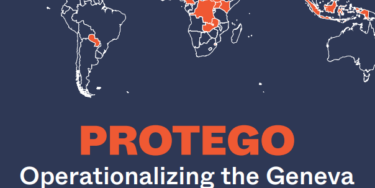General comment No. 36 (2018) on Article 6 of the ICCPR, on the right to life
(official_document)
Download PDF“The right to life is the prerequisite for the enjoyment of all other human rights” – Yuval Shany, Chair of the Human Rights Committee. This general comment provides a rich and authoritative statement of the obligations deriving from the right to life, which the Committee defines as ‘the supreme right’.
It touches on the relationship between the right to life and other human rights, as well as other international law norms. The Comment then identifies the obligations of states to protect life against a variety of challenges, including environmental degradation, war and extreme poverty. The general comment also addresses the duties of states to individuals located outside their territory, but affected nonetheless by their activities or activities of corporations based in their territory. The document also declares that states that have not yet abolished the death penalty should gradually move toward abolition.
Para. 3. The right to life is a right which should not be interpreted narrowly. It concerns the entitlement of individuals to be free from acts and omissions that are intended or may be expected to cause their unnatural or premature death, as well as to enjoy a life with dignity.
Para. 8: … States parties must provide safe, legal and effective access to abortion where the life and health of the pregnant woman or girl is at risk, and where carrying a pregnancy to term would cause the pregnant woman or girl substantial pain or suffering… States [have the duty to] ensure that women and girls do not have to undertake unsafe abortions, and they should revise their abortion laws accordingly… they should not take measures such as criminalizing pregnancies … [and] remove existing barriers that deny effective access by women and girls to safe and legal abortion [i.e. exercise of conscientious objection].
Para 23. … States [must] take special measures of protection towards persons in situation of vulnerability whose lives have been placed at particular risk because of specific threats or pre-existing patterns of violence [including] human rights defenders, officials fighting corruption and organized crime, humanitarian workers, journalists, prominent public figures, witnesses to crime, and victims of domestic and gender-based violence and human trafficking… children, especially children in street situations, unaccompanied migrant children and children in situations of armed conflict, members of ethnic and religious minorities and indigenous peoples, LGBTI persons, persons with albinism, alleged witches, displaced persons, asylum seekers, refugees and stateless persons.
Para. 26. The duty to protect life also implies that States parties should take appropriate measures to address the general conditions in society that may give rise to direct threats to life [including] high levels of criminal and gun violence, pervasive traffic and industrial accidents, degradation of the environment, deprivation of land, territories and resources of indigenous peoples, the prevalence of life threatening diseases, such as AIDS, tuberculosis or malaria, extensive substance abuse, widespread hunger and malnutrition and extreme poverty and homelessness.
Para. 61. Any deprivation of life based on discrimination in law or fact is ipso facto arbitrary in nature. Femicide, which constitutes an extreme form of gender-based violence that is directed against girls and women, is a particularly grave form of assault on the right to life.
Para. 62. Environmental degradation, climate change and unsustainable development constitute some of the most pressing and serious threats to the ability of present and future generations to enjoy the right to life. Obligations of States parties under international environmental law should thus inform the contents of article 6 of the Covenant, and the obligation of States parties to respect and ensure the right to life should also inform their relevant obligations under international environmental law.
Para. 63. … State party has an obligation to respect and to ensure the rights of all persons who are within its territory and all persons subject to its jurisdiction [where it exercises power or effective control]. This includes persons located outside any territory effectively controlled by the State, whose right to life is nonetheless impacted by its military or other activities in a direct and reasonably foreseeable manner.
Para. 64. Like the rest of the Covenant, article 6 continues to apply also in situations of armed conflict to which the rules of international humanitarian law are applicable, including to the conduct of hostilities.
Para. 65. States parties engaged in the deployment, use, sale or purchase of existing weapons and in the study, development, acquisition or adoption of weapons, and means or methods of warfare, must always consider their impact on the right to life
Download PDF

